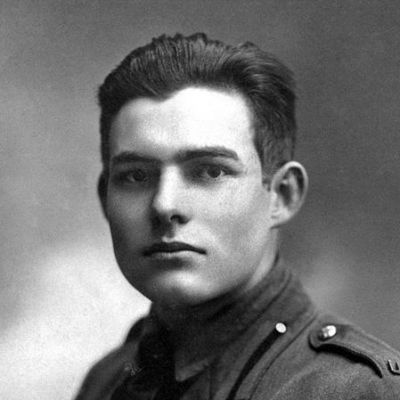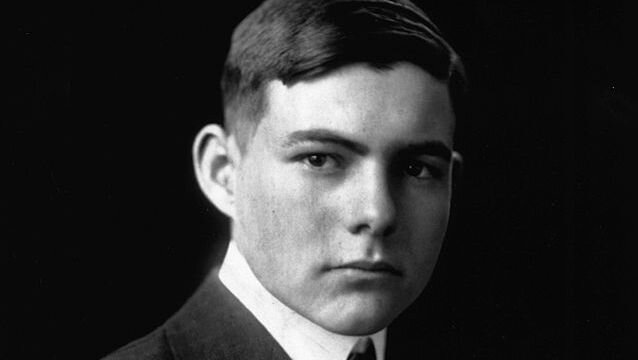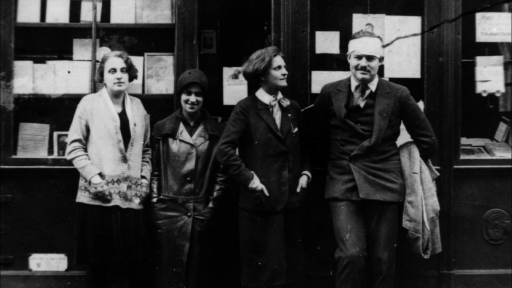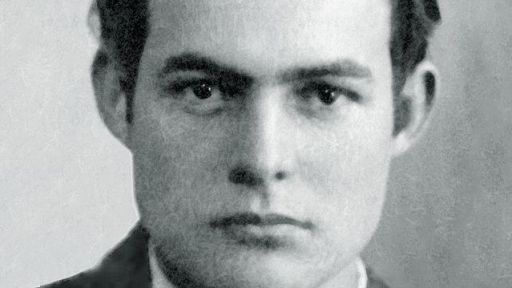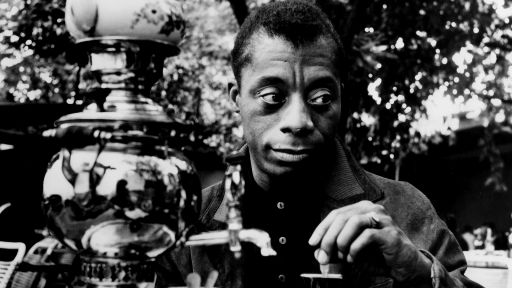When Joseph Conrad died, Ernest Hemingway, by way of an obituary notice, wrote a little piece in the TRANSATLANTIC REVIEW, in October 1924, and what he said was that if it could be shown that by grinding T. S. Eliot down to a fine powder, and by sprinkling the powder upon Conrad’s grave, then Conrad would immediately jump out of his grave and commence to write, then he, Hemingway, would leave for London immediately with a sausage grinder in his luggage.
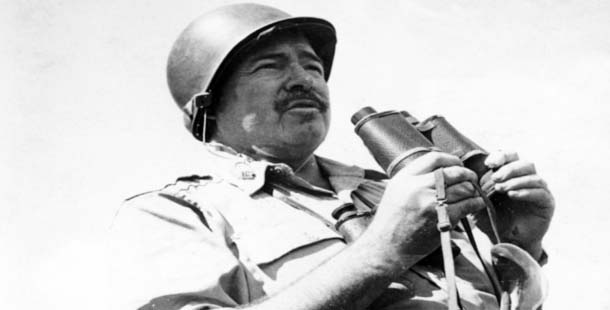 As a diversion we might consider nominating, from among contemporary novelists, candidates for the honor of being sprinkled upon Ernest Hemingway’s grave. However, we should bear in mind that this year’s list would undoubtedly differ from last year’s; this decade’s even more from last decade’s. The further back we look, the stranger are the ups and downs of reputation. Is anybody safe? Edmund Wilson, who is very good on Hemingway, was saying in 1930 that it had become fashionable to disparage him. There were many people who would have cheerfully sacrificed Hemingway upon the graves of writers now long forgotten. (The vagaries of reputation can be seen across space as well as time: in France after the war, and for a long time after it, one of the most highly regarded English novelists was Charles Morgan, who was comparatively little read in his own country; while the French, I am told, were thoroughly bewildered by the way that the English gave Albert Camus a stature hardly lower than Sartre’s.)
As a diversion we might consider nominating, from among contemporary novelists, candidates for the honor of being sprinkled upon Ernest Hemingway’s grave. However, we should bear in mind that this year’s list would undoubtedly differ from last year’s; this decade’s even more from last decade’s. The further back we look, the stranger are the ups and downs of reputation. Is anybody safe? Edmund Wilson, who is very good on Hemingway, was saying in 1930 that it had become fashionable to disparage him. There were many people who would have cheerfully sacrificed Hemingway upon the graves of writers now long forgotten. (The vagaries of reputation can be seen across space as well as time: in France after the war, and for a long time after it, one of the most highly regarded English novelists was Charles Morgan, who was comparatively little read in his own country; while the French, I am told, were thoroughly bewildered by the way that the English gave Albert Camus a stature hardly lower than Sartre’s.)
Hemingway, or course, had fame as well as reputation, a public fame which no doubt worked against his literary reputation even as it made his one of the best-known names on earth.
In the smaller world of Hemingway’s first American and British readers, the name H. L. Mencken must have seemed just as ineradicable in the twenties. In THE SUN ALSO RISES there is a two-and-a-half-page passage, when Jake and Bill are fishing, in which affectionate fun is made of Mencken 1. These two and a half pages must be baffling, and perhaps expendable, to many of Hemingway’s present readers. If it crossed the author’s mind that he was taking a bet on Mencken’s posterity, it probably seemed a fairly safe bet at the time. I happen to like Mencken, but I don’t know more than two or three people in England who have read him, let alone heard of him. I am dwelling on this ebb and flow between reputation and oblivion only to make a much-delayed point, that an entire conference on Ernest Hemingway, not to mention the existence of periodicals entirely devoted to him, in both senses, accords very well with my own opinion of his work and his lasting importance.
And this, apparently, requires some explanation. Several people, familiar with my own work, find it surprising that I should be a Hemingway enthusiast. Perhaps it is. I am not capable of confronting this puzzle head-on, but I ought to confess that this will be a somewhat egocentric talk; I will try to explain something of why I got bitten by Hemingway and stayed bitten.
One gets badly bitten by writers perhaps only two or three times, between the ages of eight and 18. The first passion I remember was for a boys’ stories writer, Arthur Ransome, when I was eight. I remember writing Runyon short stories in my teens, and a couple of Truman Capote short stories after I had left school, but I don’t think I got thoroughly bitten again until I was about 20, late for Hemingway. The general influence of Hemingway’s style is, of course, much more pervasive than that of, say, Runyon or Capote. It seems much simpler to copy. Writers have been trying to copy it for over half a century now. The other day I looked up a short story published about 20 years ago, and the first of my texts is a quotation from this story:
It had taken me days to get that far, from Avignon where they dropped me off. I had a bad time to Narbonne and in the square after the cafe closed it rained through the plane trees and the lights of heavy lorries swung big and yellow through the rain going south, but in the morning it was hot walking over the bridge and down the long straight between the vineyards, the country steaming brightly, and the first lift was a good one to Barcelona and after that it was pleasant coming down the coast all the way round through Magala with the mountains arid-brown in the corner of your eye 2.
This is part of a story published in a book called INTRODUCTION 2: STORIES BY NEW WRITERS. I was the new writer in question. So what was the great attraction?
One of the frequent explanations of Hemingway’s “fatal attraction” has to do with the glamorous interest of locale and subject matter, the bullfighting, the fishing, the big-game hunting, and the general flexing of muscles a long way from the coteries of New York and London.
Hemingway remembered a very funny conversation with James Joyce when Joyce expressed anxiety about the “suburban” nature of his subject matter. Nora apparently thought this was a good point. Jim ought to do a spot of that lion hunting, she said. Joyce objected that he couldn’t see well enough to spot the lion, and Nora argued that Ernest could shoot the lion and then lead Jim up to it so that Jim could touch it and smell it and that is all Jim would need. In his marvelous Joyce biography, Richard Ellman is sensible to the same point: He refers to Bloom as somebody whom it would be difficult to imagine catching a marlin. But of course it doesn’t matter one bit. The exotic locale and action, and the cast of hunters, gangsters, boxers, soldiers and so on, do not explain the attraction and the influence of the prose.
A second favorite explanation is that Hemingway, with his atomic prose, invented a new way of describing physical experience and the physical world.
There is something in this. Hemingway certainly helped to bury the notion, if anyone seriously held it, that the more you pile on the adjectives the closer you get to describing the thing. Refinement works against the object. The more adjectives one uses, the more precision is demanded of the description, and the more the grail recedes. One might think that this “law of refinement” would work in the opposite direction, so that the more spare the prose, the more successful the transfer of an idea or an image from writer to reader; but what it really demonstrates is that prose in itself does not describe at all. The words rely very much on what the reader brings to them. In fact, it is the associative power of words rather than their “meaning” that makes prose work on its ultimate level. It seems to me that Hemingway’s achievement, whether calculated or instinctive, was to get his effects by making the reader do the work. This was not a completely original perception (as readers of HUCKLEBERRY FINN must know), but if one tries to write like Hemingway without understanding that, as I did 20 years ago, one ends up with merely a Hemingway gloss.
Somewhere in these comments is the root of what seems to me to be the inadequate truism that Hemingway is a writer who leaves things out.
My own memory of reading Hemingway for the first time is of being often intrigued by what he had put in and left in. In “The Killers” when Nick tries to warn the boxer about the two gangsters who have come to the restaurant to kill him, he goes to what has been referred to as “Mrs. Hirsch’s rooming house,” and when he leaves the place he says to the woman who runs the house, “Well, good-night, Mrs. Hirsch,” and she says “I’m not Mrs. Hirsch. … She owns the place. I just look after it for her. I’m Mrs. Bell.” “Well, good-night, Mrs. Bell,” says Nick 3. Mrs. Bell says good night. What on earth is this about? It has nothing to do with the story. But it makes the boxer real and the gangsters real.
The mysterious nature of the power of prose to describe is best exemplified for me in the story “Big Two-Hearted River,” because I have fished for trout since I was a small child and the power of the “association” as opposed to the “meaning” makes me one of the ideal readers of that story. At the same time, the way the words were put together disturbed me when I first read this story. Here is a paragraph from it:
As the shadow of the kingfisher moved up the stream, a big trout shot upstream in a long angle, only his shadow marking the angle, then lost his shadow as he came through the surface of the water, caught the sun, then, as he went back into the stream under the surface, his shadow seemed to float under the bridge where he tightened facing up into the current 4.
This bothered me because as a journalist I was going to a lot of trouble trying to avoid repeating words, and the repetition of “stream,” “upstream,” “shadow,” and “angle” at first jarred like music that had gone wrong. It was an education to me that there were different kinds of music and that prose could make a more interesting kind of noise in the brain.
But finding description persuasive and effective cannot depend upon its being checked against experience, and this brings me to the first three Hemingway quotations which made a great impact on me, and which in a slightly arbitrary way are going to be invoked now in order to help me to feel my way, by trying to explain the impact, toward some understanding of why I got bitten. The first quotation is from one of the vignettes in IN OUR TIME, the death of the bullfighter Maera:
There was a great shouting going on in the grandstand overhead. Maera felt everything getting larger and larger and then smaller and smaller. Then it got larger and larger and larger and then smaller and smaller. Then everything commenced to run faster and faster as when they speed up a cinematograph film. Then he was dead 5.
I am in no hurry to check this one out but I thought then and I still think that this is extraordinarily brilliant and just as persuasive as the description of fishing for trout.
The second quotation is from THE SUN ALSO RISES:
The bull who killed Vicente Girones was named Bocanegra, was Number 118 of the bull-breeding establishment of Sanchez Taberno, and was killed by Pedro Romero as the third bull of that same afternoon. His ear was cut by popular acclamation and given to Pedro Romero, who, in turn, gave it to Brett, who wrapped it in a handkerchief belonging to myself, and left both ear and handkerchief, along with a number of Muratti cigarette-stubs, shoved far back in the drawer of the bed-table that stood beside her bed in the Hotel Montoya, in Pamplona6.
When I read this paragraph I always think of some heavy object bumping slowly down a flight of stairs, and in some way picking up not moss as it rolls but bits and pieces, objects, debris, fragments of the whole novel, so that the life of the peasant who didn’t run fast enough in front of the bulls and the alien Americans with their romanticism and their self-indulgences are locked up together and rubbed raw against each other in a paragraph which is mostly concerned with small concrete objects, and which, just to make the whole thing breathtaking, leaps forward in time way beyond the point we have reached in the story. I think that this is one of the greatest paragraphs ever written in English, and if there is a better one perhaps it is this:
William Campbell had been in a pursuit race with a burlesque show ever since Pittsburgh. In a pursuit race, in bicycle racing, riders start at equal intervals to ride after one another. They ride very fast because the race is usually limited to a short distance and if they slow their riding another rider who maintains his pace will make up the space that separated them equally at the start. As soon as a rider is caught and passed he is out of the race and must get down from his bicycle and leave the track. If none of the riders are caught the winner of the race is the one who has gained the most distance. In most pursuit races, if there are only two riders, one of the riders is caught inside of six miles. The burlesque show caught William Campbell at Kansas City 7.
This is a piece of writing that mimics its subject matter. It is a paragraph in which a burlesque show is in a pursuit race with a metaphor. And what happens is that the burlesque show catches up on the metaphor and the metaphor has to get down from its bicycle and leave the page.
Looking back at my three quotations, and at my attempt to draw something from them, one wonders how subjective is my response, whether in fact I have succeeded in demonstrating anything at all, and one perhaps wonders, too, about the possibility of truly objective criticism and assessment. I have brought with me the first FITZGERALD/HEMINGWAY ANNUAL (1969), which contains an essay entitled “A Comparative Statistical Analysis of the Prose Styles of F. Scott Fitzgerald and Ernest Hemingway8.”
The first sentence is as follows: “Statistics supply the one asset in which literary criticism, especially stylistic criticism, has always been woefully deficient-proof.” This is followed by a mild rebuke. “Numerical proof may never take the place of critical sensitivity, but by presenting good solid evidence, one can base his description and evaluation of an author’s style on a good solid foundation that cannot be ignored by future critics who wish to escape into the never-never land of impressionistic criticism.” At the end of the essay there are some statistical tables which reveal, among other things, that comparing “Big Two-Hearted River” with Fitzgerald’s “The Rich Boy” the average sentence contains 12 and 24 words, respectively; that the percentage of simple sentences is 73 percent and 24 percent, respectively; that the percentage of substantives that are monosyllables is 72 percent and 61 percent; and so on, with other comparisons between each writer’s early and late work.
The author of this essay is obviously a bright woman, easily bright enough to see that there is something dubious about the whole exercise. “It may be argued,” she writes, “that differing subject matter and point of view affects reliability of comparative statistics.” She mentions other limitations, and ends up more or less nullifying her first two sentences by conceding that “figures alone cannot describe or explain all of what makes a writer’s style uniquely his own,” and she adds that statistical analysis is useless to explain what makes a particular Fitzgerald sentence uniquely Fitzgeraldian.
This whole thing reminded me of a fight I once saw on television which was supposed to have been between Muhammad Ali and Rocky Marciano (who unfortunately had been dead for some years). The fight had been worked out by a computer. Muhammad Ali actually fought this person who looked like Mr. Marciano. I forgot who won, because, of course, the result was not memorable since it was not enlightening. In trying to explain the attraction of art, the more indisputable a fact the less useful it becomes. Consider the proposition that Virginia Woolf was the tallest woman writer in Bloomsbury in 1922. No doubt the computers are at work on her now and will prove a lot of things, including, if desired, her chances against Marciano.
I feel almost obliged to say something about THE FIFTH COLUMN, which is “the Hemingway play.” Here we have the Hemingway hero who affords ammunition to Hemingway critics. There is a beautiful woman who is mad about him, and he is very brave and much cleverer and wittier than the poor duffer who loved the woman before. Talking about THE FIFTH COLUMN, someone once made what I thought was the perceptive comment that in this play Hemingway was going through the necessary process of separating from his involvement in a political cause and his closeness to events and getting rid of a crude version of a subject which he could approach later with an artist’s detachment. However, Hemingway thought well enough of the play to have it published with his collected short stories, and this is the Hemingway who draws the fire of critics like Dwight Macdonald. When a professor of English remarked that Hemingway was essentially a philosophical writer, Macdonald thought it to be “a rather foolish statement, even for a professor of English.” The feeling that loyalty and bravery were the cardinal virtues and that physical action was the basis of the good life didn’t add up to a philosophy, said Macdonald. This does not seem to be an adequate comment. It is not simply physical action but the action of the physical world upon the individual that is important in Hemingway’s work and in his thought, too, for it is also inadequate to think of “philosophy” as something quite so detached from the ordinary business of living and surviving. It is also surely part of Hemingway’s philosophy, to use a word he probably wouldn’t use, that an appreciation and celebration of the physical, sensual experience of life, which unites writers, philosophers, fisherman, bullfighters, and critics, are not to be despised by the ivory tower philosopher. The force of a code of behavior, of a personal morality, is that philosophy does not account for it but is accountable to it.
by Tom Stoppard
Notes
1. Ernest Hemingway, THE SUN ALSO RISES (New York: Scribner’s, 1926), pp. 122-25.
2. See INTRODUCTION 2: STORIES BY NEW WRITERS (London: Faber and Faber, 1964).
3. Ernest Hemingway, “The Killers,” THE SHORT STORIES OF ERNEST HEMINGWAY (New York: Scribner’s, 1938), p. 288.
4. Ernest Hemingway, “Big Two-Hearted River,” SHORT STORIES, p. 210.
5. Ernest Hemingway, “Chapter XIV,” SHORT STORIES, p. 207.
6. Hemingway, THE SUN ALSO RISES, p. 199.
7. Ernest Hemingway, “A Pursuit Race,” SHORT STORIES, p. 350.
8. Elizabeth Wells, “A Comparative Statistical Analysis of the Prose Styles of F. Scott Fitzgerald and Ernest Hemingway,” FITZGERALD/HEMINGWAY ANNUAL (1969), pp. 47-67.
This essay was excerpted from:
Nagel, James., Ed. ERNEST HEMINGWAY: THE WRITER IN CONTEXT. © 1984.
Reprinted by permission of The University of Wisconsin Press.
Tom Stoppard is a British writer whose works include the plays ROSENCRANTZ AND GILDENSTERN ARE DEAD (1966), JUMPERS (1972), and TRAVESTIES (1974) as well as the screenplays for BRAZIL (1985), EMPIRE OF THE SUN (1987), and SHAKESPEARE IN LOVE (1998).

